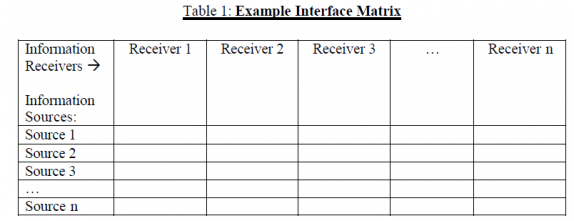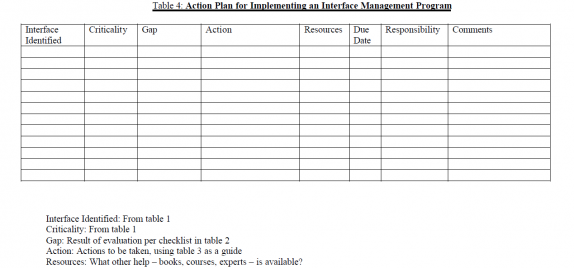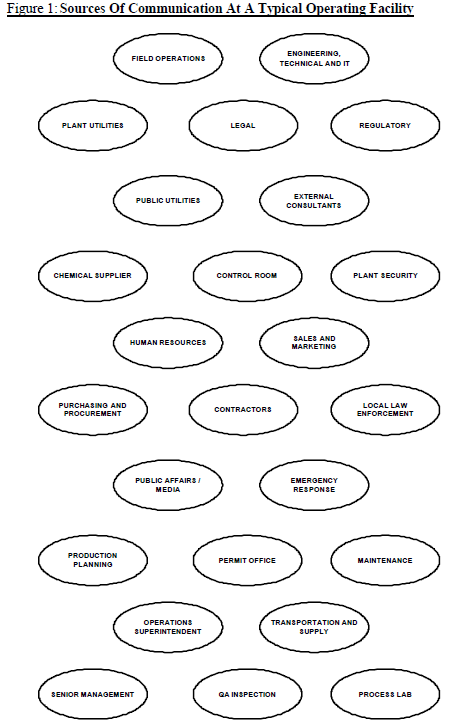Introduction
Not too long ago, a process safety leader visited a plant his company recently acquired to review that plant’s procedures. Keen to see how process conditions were communicated between shifts, he positioned himself in the control room during shift change. He watched as the outgoing shift “high-fived” the incoming shift and slumped out the door. The few words that were spoken were mainly of a personal nature. The new shift then took their positions at the console and assumed control of the plant operations. The process safety leader wondered what the oncoming shift knew about the plant’s condition and operations. Was the process running within normal limits? Was maintenance about to take a key back-up pump out of service? Was there any carry-over maintenance? Had the outgoing shift been troubled by alarms? Unless the two shifts were communicating telepathically, this critical information was not shared. People interface problems have existed almost forever, but first came to light in an industrial setting in 1979 following the Three Mile Island nuclear incident. Several people in key positions in the control room made individual assumptions based on perceived observations and the result was chaos and confusion. Management interface problems were also highlighted in the investigation findings of Piper Alpha, Phillips Pasadena and the Exxon Valdez disasters. Today’s trend of streamlined organizations and reduced staffing makes it even more important that companies recognize that organizational changes usually result in interface changes. With this awareness they can then make appropriate adjustments in how information is exchanged.
In a January, 2002 meeting, representatives of CCPS member companies conducted a workshop to discuss “Interface Management”, recognizing that communications critical to process safety don’t just happen on their own – each interface must be managed.
What is Interface Management?
In the context discussed here, Interface Management is the systematic control of all communications that support a process operation. Given the significance of human involvement in most operations, it is important that interactions between people be managed and carefully coordinated to avoid incidents resulting from misunderstandings and lack of information. While such coordination is not formally defined as a Process Safety Management (PSM) element, it is obviously needed and assumed to exist in each element. It doesn’t take much research to uncover several noteworthy incidents in the past decade that demonstrate the need to ensure a consistent high quality exchange of information between persons responsible for operating our chemical plants and oil refineries. Interface management is a key component of effective leadership in any organization.
Criteria for Identifying Interfaces to Manage
A “one size fits all” approach is neither reasonable nor practical. The approach must be risk based and tailored considering the company and facility culture, history, and resources. This tailored risk-based approach must meet the primary criteria of recognizing those situations or activities that might lead to a loss of containment incident with ensuing unwanted consequences. As a secondary criterion, the same approach could be used to designate those communication interfaces that might affect product quality or volume of production. Other operating efficiencies might be addressed as a lower level criterion. In many plants, the control room is considered to be the communication hub. But, there are some communications that must take place between different disciplines in the field and it may not be possible for supervisory personnel to directly oversee these.
Putting Interface Management into Practice
To address these issues, each operating plant or facility should develop an inventory of communication interfaces important to running the operation safely. Figure 1 shows many of the functions in a plant that may have to communicate with another function. These should be risk ranked for criticality. Those that contain high-risk critical data or information should be documented. One such example might be a shift turnover log. Merely requiring that such documentation be completed may not be sufficient; a standard format including the disclosure of critical operating parameters should be considered. Once the communication list is established, the timing of critical communication interfaces should be considered. If communications are to be standardized they must be referenced to a common activity or conducted at a specific hour. This will help ensure their rigor and consistency. On a similar note, interfaces that could introduce error or confusion should be discouraged. For example, persons who are not authorized to approve work orders or to contact public authorities must be made aware of their authority restrictions. Many large organizations have standard communication protocols that appear to work effectively. These may be entrenched in the culture as a result of experienced workers or reside within the startup procedures and pre-startup reviews. If your organization has recently undergone change, if you anticipate change, or even if your organization might lose some of its experienced workers, are systems in place to ensure that interface management will continue at a high enough level to control risk? An audit or analysis of your practices based on risk may be in order. Although this document has focused on Interface Management with regard to plant operations, similarly thorough communication processes are also essential to the execution of major projects, particularly those with many parties involved such as project management, contractors and subcontractors, and future operating personnel.
How to Proceed
The three steps suggested below outline a methodology suggested as a result of the
workshop:
- Identify and Evaluate Interfaces
- Determine if Interface Management Practices are Sufficient
- Complete Action Plan to Improve Interfaces
Identify and Evaluate Interfaces
How well established are the interfaces at your facility? Do they control risk to a manageable level? To find out, develop a matrix listing all the sources of information on the left side and all receivers of information across the top. The intersecting boxes on the matrix should be checked if there is an interface requirement. Those interfaces that could result in a significant process safety incident if not conducted properly should be designated as critical and addressed with rigorous standards.

In each cell, identify whether that interface is a critical interface, indicating criticality
according to the following key:
P = Process Safety Critical
Q = Quality Critical
E = Environment Critical
Etc.
Determine if Interface Management Practices are Sufficient
The two tables below will help you navigate this process to determine whether interface management practices are sufficiently defined and practiced at your facility. As in any checklist approach, it is important to review all questions to be sure they apply to your situation, and that you have not omitted any questions important to your company that are not included here.
Table 2: Evaluating Interface Management
- Is a single person designated in charge of your operation or facility on a round the clock basis?
- Are roles and responsibilities regarding communications clearly defined for this individual?
- Are external communication responsibilities included? e.g. police, fire, medical
- Are formal records and documents passed on to management for their review?
- Is a system in place that establishes the importance or criticality of communications in the field?
- Are communication protocols established between key operating positions?
- Are there any language barriers that might impede effective communications? Are persons identified on shift that can intervene in difficult communications?
- Is a system in place to communicate the status of equipment between Maintenance and Operations?
- Is a system established for procurement of emergency supplies, parts and chemicals during odd hours?
- Is a system in place to ensure timely and accurate communications between complimentary positions at shift change?
- Is a system in place to counteract or revoke standing orders and instructions made necessary by changing conditions?
- Is a system in place to communicate emergency instructions to all personnel including contractors and subcontractors?
- Is there a system that allows workers to challenge instructions that may be unclear or inappropriate?
Table 3: Interface Management Considerations
1. What information is required? What is the critical content?
2. Why is this information important and how will it be used?
3. Who will use this information and who is authorized to provide it?
4. What is the mode and style of communication? One way or two way?
5. When is this communication required? Regularly scheduled or event triggered?
6. How is it documented? Is there a record of occurrence?
Complete Action Plan to Improve Interfaces
Now that you have identified the most important interfaces to manage, complete the table 4 on the following page to develop your action plan.


Acknowledgements
CCPS would like to thank the its Technical Steering Committee for their enthusiastic participation in the Workshop, to Brian Kelly for organizing the workshop and editing the workshop comments, to Adrian Sepeda, Mike Broadribb, and Bob Stankovich for providing substantial editorial comments, and to Bob Stankovich, Bernard McGarvey, Chuck Fryman, and John Alderman for identifying additional reading on this topic.
Additional Reading
1. Reason, James, “Managing the Risks of Organizational Accidents,” Ashgate Publishing Company,
1998
2. “Piper Alpha – Spiral to Disaster,” (Videotape), Health Safety Executive of the UK, available as
AIChE publication number Y-71
3. “Phillips Explosion,” (Videotape and lecture), SACHE, AIChE publication number Y-32
4. “Guidelines for Preventing Human Error in Process Safety”, CCPS, 1994, publication G-15
5. Attwood, Dennis, Deeb, Joseph, and Danz-Reece, Mary, “Ergonomic Solutions for the Process
Industries”, Elsevier, 2003
6. “Practical Application of Human Factors,” CCPS, in preparation
